There is a new LEGO book I have been reading, titled LEGO Optics: Projects in Optical and Laser Science with LEGO, written by Grady Koch. Yep, the book is exactly what the title make it sound like; full of interesting science projects using LEGO elements. 🙂
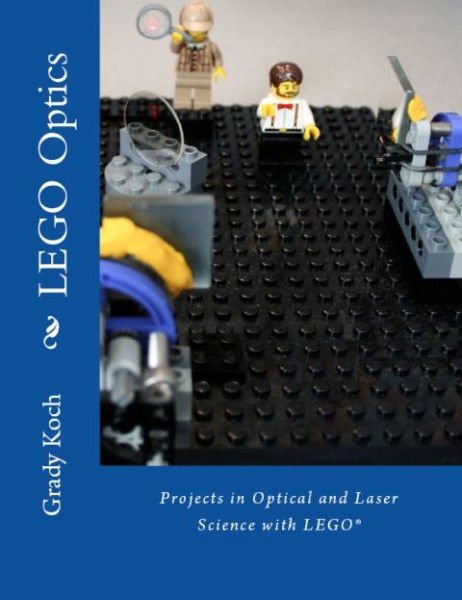
The background of this book is really interesting. Grady is an electro-optical engineer, building laser instruments for applications in atmospheric science and aviation. In the introduction of the book he shares that one time while working on a project with a deadline, a component failed on the eve of departing for an expensive and high-profile field experiment. Grady was scrambling and turned to the Internet to find a solution and get the faulty component fixed. However to his dismay he discovered that some critical electronic parts had become obsolete, which meant that he would have to redesign a circuit with modern parts, make a new printed circuit board, and some other stuff – all of which would be impossible to accomplish by the deadline. Out of desperation Grady turned to his childhood LEGO bricks. He replaced the function of the broken device with a LEGO contraption solidified with a few drops of Krazy Glue. The device worked, the project schedule was saved, and Grady re-discovered his childhood idea that anything can be made out of LEGO bricks – even high-tech scientific instruments!
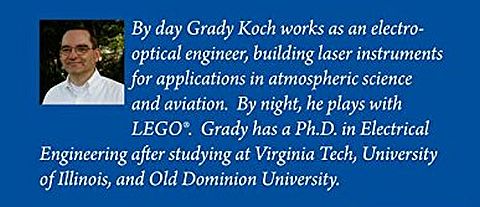
There are LEGO fans who stay within the boundaries of the LEGO system, and treat it strictly as a hobby; they build LEGO towns, castles and spaceships, using LEGO elements. Then there are those who build working machines and engines using LEGO bricks – we have featured several of them here (see links at the end of this post), and there are also some people who use LEGO to build and fix things in their daily lives; things like smart-phone cases, pencil holders, book ends and more. And when you give LEGO to an electro-optical engineer like Grady, he is going to build lenses, and lasers, and mirrors and all kinds of other magical contraptions.
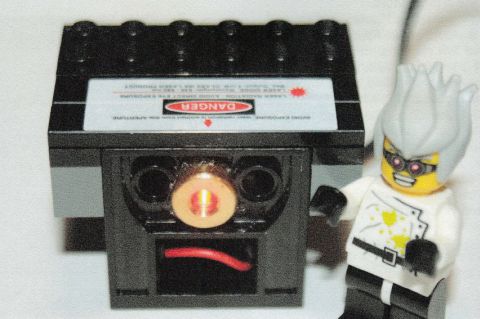
While LEGO doesn’t specifically make optical components like mirrors, lasers, or beam-splitters, there are actually a few LEGO parts that can serve as optical elements like the LEGO magnifying glass or LEGO light-brick. However in the realm of experiments with optics, LEGO bricks best serve as a means to hold and manipulate optical elements – which is actually a really important aspect, a lack of which often holds back students or hobbyists from realizing their projects. The combination of various optical elements coupled with the mechanical precision of LEGO bricks allows the implementation of some rather complex inventions.
Here is the description of the LEGO Optics: Projects in Optical and Laser Science: Discover how to incorporate laser and optical components into LEGO. Step-by-step instructions are given for the advanced (high school to adult) builder. These high-tech projects include: lenses, custom-color LED light bricks, LEGO laser, mirrors (with a laser light show), optomechanics, Michelson interferometer, and LEGO holography. Yeah, you read that right; holography! 😀
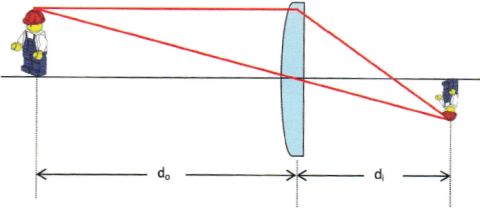
Please note that since this book is meant to be a series of building projects, the emphasis is on practical instructions with just enough science background to understand what is going on. After each project is built, there is a “How It Works” section to give a little more explanation of the science and math behind the project. The book is set at a level of a science/math interested high-school student or adult LEGO fan. A background in algebra, trigonometry, and introductory physics is presumed. The building skills to recreate the inventions is also of a high-school student, though a middle-school student could work through the inventions with adult help. Some of the projects require the modification of LEGO elements (this is kept to a minimum), which would require adult help; such as using a drill, tapping a hole or soldering connections. Appropriate machine-shop safety practices are needed when working with these tools.
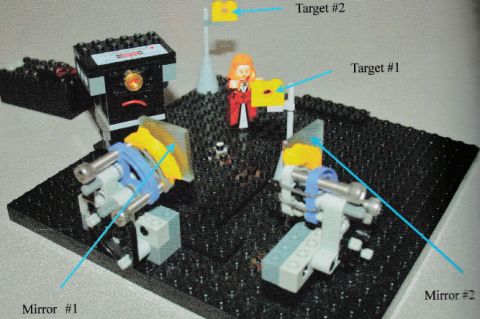
There are seven projects in the book LEGO Optics: Projects in Optical and Laser Science, and while they stand on their own, they also build on each other: The first chapter deals with lenses, the second chapter with making custom color LEGO light-bricks, and in the third chapter you learn to build a LEGO laser. The fourth chapter is about mirrors, and the fifth chapter is on optomechanics (which deals with the combination of optical science and mechanical engineering) with a cool project. The sixth chapter is building a Michelson interferometer (a device that uses the properties of laser light to detect very small motions and vibrations), and also leads up to the seventh chapter where you learn to make LEGO holograms.
For each project there is a part-list for both LEGO and non-LEGO components that you will need, as well as tools used. When non-LEGO parts are needed resources are given as far as where to get them. These include things like LED lights, small mirrors, batteries, glue, putty, laser diodes and holographic plates. There are also step-by-step instructions with color pictures (either photographs or digital images). The book is soft-bound and 124 pages long, so it is not too big for the casual tinkerer, but big enough to give you enough details on each project.

I think this is a great book for high-school students and adults who like to experiment with scientific projects. For kids who are into optics and engineering it is an excellent hands-on introduction that may steer them towards a chosen scientific field. It could very well be included in school-curriculum as most kids would have some LEGO lying around they could use for the projects. The only thing I didn’t like about the book are some of the photographs (like for example the one on the front cover) – sometimes they are a bit too dark or not sharp enough. This doesn’t in any way take away from being able to follow the instructions for the projects, it is simply an aesthetic issue. This is not a LEGO art or picture gallery book, so it can be overlooked, but I thought to mention it for the sake of the completeness.
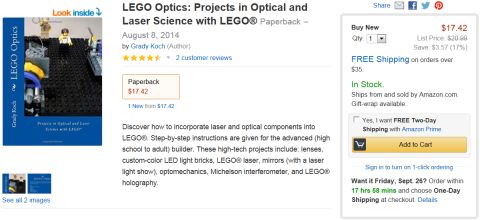
LEGO Optics: Projects in Optical and Laser Science is available on Amazon. The normal price is $20.99, Amazon’s price is currently $17.42 (this may fluctuate at times). You can find the book listed on Amazon at this link: BUY LEGO OPTICS BOOK ON AMAZON
So what do you think? Are you interested to tinker with scientific projects? Have you ever use LEGO for this purpose? What did you build? Feel free to share and discuss in the comment section below! 😉
And you might also like to check out the following related posts:












Cool! You could make Starwars holograms in real life!
Fitst comment!
Exactly!
Normally I’m a purist when it comes to things I build. However, this might be something I’d be willing to experiment with and break that habbit.
He-he… yeah, especially the last chapter with holography, just wants you to break the rules. 😉
Very interesting! I’d like to try that holography experiment. However, I’m not up to the modifying pieces challenge, as I don’t have enough pieces not from sets to build with as it is. 🙁
I agree that his photography could be better; his focus is off. In the first picture his focus seems to be about 7 studs in front of the minifig, which is why most of the main parts of the picture are blurred. Funny, as photography is an Optical hobby. 😉
Also, the 2015 Bionicle, LEGO Movie, and DC Super Heroes set images are out; you can see them on Brickset. 🙂
Not all of them are up, I think, but a lot of them…
Yes, not all of the Bionicle, we’re missing Onua and the Protecters. And also one Justics League set is missing.
I guess someone can be great at one branch of optical hobbies and not with the other. I know I don’t have much patience for photography either, even though I like tinkering. So sometimes it is best to hire a professional photographer for larger projects. Anyhow, all of the pictures included in the book are clear enough to follow instructions. Yes, I have also seen the new set pictures! AWESOME! 😀
Sweet! Thanks for highlighting this, I’d not heard of it.
Tim, you are very welcome. Yes, this is a newly released book. I have been in touch with the author. 🙂
Off-topic, but I’m still working on my SHIP for SHIPtember. Are you allowed to use a previously built ship, or do you have to build one from scratch?
My understanding is that for competitions you are usually required to submit something you have never shared before. Now, if you built it months ago and you never shared it online you should be able to enter it, but if you took pictures and posted them before then you likely can’t enter them. But I would suggest to double check the contest rules.
OK, this is off topic, but I think I’ll share this with you: Brickset member Just2good has been posting videos showing official 2015 sets. He’s already done the DC Super Heroes, Speed Champions,* Bionicle, and the LEGO Movie, and tomorrow he’ll post Ninjago. 🙂 Seems so early to disclose the images, though. Is it always this early? Last year Ninjago was first shown in November. 😕
*For your info, there’s more stickers than bricks on those sets, but they are all minifig scale, which is nice. 😉
These are leaked images just2good somehow got hold of. They were not officially released by LEGO. There is no official release date for leaked images. 😉
The first leaked images actually appeared a couple of weeks ago. It included most of the 2015 sets, but since they were watermarked with the confidentiality stamp, I couldn’t share them. But yes, they have been around, and there is a lot more to come. 😛
But why? Why do people have to share them so early? Can’t they wait until LEGO just does it themselves? It’d be better, I think.
Human nature. Everybody wants to be first to share something and to know something. Sharing images before the official launch can actually hurt LEGO as it gives an adventage to competitors. But this does not stop LEGO fans to hunt for leaked images and such. LEGO blogs and forums have gotten much better about censoring themselves and not sharing leaked images, however this does not stop people to leak them elsewhere like YouTube and various social platforms.
Personally I don’t go out of my way to find leaked stuff, but if it is shared somewhere I do look at them. It helps me plan what sets I’m going to save up for, gives me ideas for future projects, etc. It can also save money. Like for example if there is a minifig that currently only appears in one expensive set, but I know it will later appear in a cheaper set, I’m not going to pay more for that minifig than I need to. I will wait until the cheaper version appears.
Agreed. And human nature is right, my brothers were just digging up prelim images on Google of the 2015 City, and they also found the Pirates and two Technic. Of course, they aren’t the first to find them. 😐 I think people should just wait, it gives more of a surprise when the high-quality images suddenly appear. But, anyways, 15 days to wait for more (better) Hobbit set images. 😉